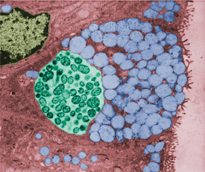Sexually Transmitted Diseases
 What are some of the most commonly reported sexually transmitted diseases?
What are some of the most commonly reported sexually transmitted diseases?
Diseases that spread by sexual contact, or sexually transmitted diseases (STDs), are a serious health problem in the United States. A 2008 study by the Centers for Disease Control and Prevention showed that one in four girls and young women aged 14 to 19 were infected with an STD.

FIGURE 34–16 Chlamydia Infection This electron micrograph shows a cluster of C. trachomatis bacteria (green) growing inside a mucus-secreting cell within a female reproductive tract. The bacteria will eventually overwhelm the cell and cause it to burst, allowing the infection to spread (TEM 2400×).
Unfortunately, public health information about STDs has not kept pace with the rate of infection. For example, one might think that the name of the most commonly reported infectious disease in the United States would be a household word, but it isn't.  Chlamydia is not only the most common bacterial STD, it is the most commonly reported bacterial disease in the United States. Chlamydia, which damages the reproductive tract and can lead to infertility, is caused by a bacterium that is spread by sexual contact. Other bacterial STDs include gonorrhea and syphilis.
Chlamydia is not only the most common bacterial STD, it is the most commonly reported bacterial disease in the United States. Chlamydia, which damages the reproductive tract and can lead to infertility, is caused by a bacterium that is spread by sexual contact. Other bacterial STDs include gonorrhea and syphilis.
Viruses can also cause STDs.  Viral STDs include hepatitis B, genital herpes, genital warts, and AIDS. Unlike the bacterial STDs, viral infections cannot be treated with antibiotics.
Viral STDs include hepatitis B, genital herpes, genital warts, and AIDS. Unlike the bacterial STDs, viral infections cannot be treated with antibiotics.
Some viral STDs, such as AIDS, can be fatal. Tens of thousands of people in the United States die from AIDS each year. In addition, the virus that causes genital warts—human papillomavirus (HPV)—is a major cause of cervical cancer in women. Recently, a vaccine has been developed that can prevent some HPV infections. To be effective, the vaccine must be administered before a woman is infected with HPV.
STDs can be avoided. Any sexual contact carries with it the chance of infection. The safest course to follow is to abstain from sexual contact before marriage, and for both partners in a committed relationship to remain faithful. The next safest course is to use a latex condom, but even condoms do not provide 100 percent protection.
34.3 Assessment

-
Review Explain what happens during puberty.
Compare and Contrast Compare and contrast the sexual development of male embryos to that of female embryos.
-
Review Describe the function of the male reproductive system.
Sequence Explain how sperm develop.
-
Review Describe the functions of the female reproductive system.
Interpret Visuals What happens during each stage of the menstrual cycle? Hint: Refer to Figure 34–14.
-
Review Name two STDs caused by bacteria and two caused by viruses.
Evaluate Why do you think that young people are especially at risk for STDs?
Apply the Big idea
Sperm cells contain numerous mitochondria. Use what you learned about mitochondria in Chapter 7 to explain how mitochondria might influence sperm activity.

Table of Contents
- Formulas and Equations
- Applying Formulas and Equations
- Mean, Median, and Mode
- Estimation
- Using Measurements in Calculations
- Effects of Measurement Errors
- Accuracy
- Precision
- Comparing Accuracy and Precision
- Significant Figures
- Calculating With Significant Figures
- Scientific Notation
- Calculating With Scientific Notation
- Dimensional Analysis
- Applying Dimensional Analysis




